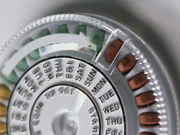Current use of estrogen-containing contraceptive associated with 20 percent increase in 25(OH)D
MONDAY, Aug. 8, 2016 (HealthDay News) — Current use of an estrogen-containing contraceptive is associated with an increase in 25-hydroxyvitamin D (25[OH]D), according to a study published online Aug. 4 in the Journal of Clinical Endocrinology & Metabolism.
Quaker E. Harmon, M.D., Ph.D., from the National Institute of Environmental Health Sciences in Research Triangle Park, N.C., and colleagues examined the correlation between hormonal contraception use and 25(OH)D. After adjustment for other factors, the authors examined the percent change in season-adjusted serum 25(OH)D with estrogen use among 1,662 African-American women aged 23 to 34 years living in the Detroit area.
The researchers found that serum 25(OH)D concentrations were low, with 70 percent <20 ng/mL. After adjustment, there was a 20 percent increase in 25(OH)D with current use of an estrogen-containing contraceptive. Participants who had used estrogen in the past, but were not current users, had no increase in 25(OH)D.
“The increase in 25(OH)D with use of estrogen-containing contraceptives [raises] mechanistic questions regarding the biological pathways involved, and highlights the need for studies that examine possible endogenous estrogen effects on vitamin D,” the authors write.
Copyright © 2016 HealthDay. All rights reserved.








